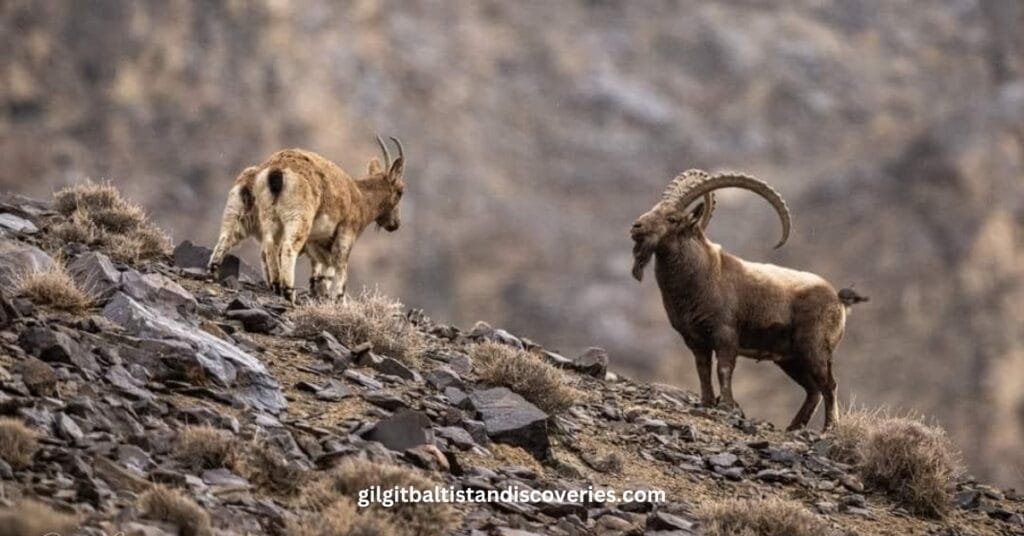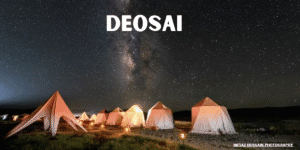Welcome to Gilgit-Baltistan, where some of the most wonderful mountain-type Gilgit Baltistan animals shelter in these rugged mountains and serene valleys. Whether it is an animal enthusiast or an adventure, the rich biodiversity here is a dream come true. Let’s look at these incredible animals and the places where you can visit them nearby. Trust me, you will want to pack your bags after reading this!
Read More: All About Gilgit Baltistan – Travel Northern Pakistan Guide 2024

Table of Contents
Toggle1. The Snow Leopard-A Stealthy Predator
The snow leopard is arguably the most famous of all Gilgit Baltistan animals. It spot within the high-altitude mountain geography of Khunjerab National Park and Deosai National Park. Khunjerab offers excellent open landscapes with snow-covered peaks to spot the snow leopard in winter. These are must-visit destinations for the animal photographer and the adventure-seeker looking to catch sight of this ghostly predator. If ever you are searching for an unforgettable animal experience, this is it!
2. Markhor-National Pride of Pakistan
This is among the legendary Markhors, found dwelling in the steep lands of Chitral National Park and Toshi Game Reserve. This national symbol of Pakistan boasts twisted horns and excellent agility on rocky slopes. The Gilgit Baltistan animals in that region vary vastly, but the largest attraction is the Markhor. Adventure seekers groups to these areas not only because of the animals but also for the beautiful ranges and rugged beauty. If you are visiting Chitral, be sure to hike through the reserves, where you can watch these magnificent creatures leap across thorny cliffs. That is something that should be on every traveller’s list.
3. Himalayan Brown/Bear-The Great Giant
Himalayan brown bears can also be seen within the Deosai National Park, famously known as the ‘Land of Giants‘. Huge wide stretches of terrain that belong to this flatland shelter plenty of giant bears and appear somewhat like a world of dreams, attracting several travellers from around the earth. During spring and summer, wildflowers bloom within the meadows of Deosai, making it a great place for nature walking and clicking photographs. In addition, you will be indeed fascinated by the views if you are lucky enough. Moreover, you might even catch sight of one of these awesome bears.
4. Ibex-The Agile Mountain Goat
The Siberian ibex is another of the breathtaking Gilgit Baltistan animals seen in the Karakoram Range and Hunza Valley. Mountain goats for their navigation skills for fast climber’s cliffs are well-known. The first thing a person hears about Hunza is the serenity of its landscapes, but wildlife Fans visit it to see ibex grazing on mountain slopes. Therefore, trekking through the mountains is exciting enough as you spot these quick animals in their natural habitat.
5. Lynx-The Silent Hunter
One of the more elusive creatures of Gilgit Baltistan. The lynx is commonly found in Astore Valley and Naltar Valley forests. The elusive animals are medium-sized wildcats that prefer dense forests and shrublands. Therefore, elusive but exciting to meet, yet serene landscapes abound within Astore and Naltar, making it easy to combine an animal-spotters trip with treks and camps. The valleys, with their dense forests and cool summer temperatures, offer the perfect escape for anyone looking to beat the heat and enjoy nature.
6. Marco Polo Sheep-Horns of Glory
The Marco Polo animal lives in the border areas of the Pamir Mountain region, specifically in the Khunjerab National Park. Known as having the largest spiral horns among sheep and rarely spotted, seeing one of these animals is a treasure. The Khunjerab Pass is also considered the world’s highest-covered international border crossing. Moreover, this trip includes incredible animal viewing and breathtaking mountain scenery. This trip is ideal for animal fans and adventure-seekers alike.
7. Musk Deer-The Mysterious Creature
Musk deer, shy and solitary, is found in the high-altitude forests of Gilgit-Baltistan and can generally be found in the Astore Valley and Skardu. Fitted with narrow bodies and long, very long hind limbs, these animals can easily move up the steep, rocky slopes. These animals feed mainly on grasses, leaves, and moss. The musk deer makes its appearance unique with a musk gland on the male. In addition, it has been desired for perfumes and medicinal purposes for years. Hence, they are widely approachable for hunting, giving a reason for conserving them.
8. Tibetan Wolf – The Predator
The grey wolf is the subspecies of the Tibetan wolf found in the rugged grounds of Gilgit-Baltistan, mainly in the Karakoram Range and the Deosai National Park. The climate has molded it to this condition and wolves have dark, soft coats ranging between shades of grey and sandy soils. Their hunting technique usually involves a pack; they certainly show great team spirit in taking down prey like wild goats and ibex. They float effortlessly over sharp rocky landscapes. Beyond performing their ecological role, Tibetan wolves also play cultural roles in the folklore of the local people, symbolizing power and endurance. Seeing one in the wild is exciting because it instils a feeling of connection with the region’s rich biodiversity.
9. Bharal-The Blue Sheep
The Bharal, also known colloquially as the blue sheep, is a handsome animal that occurs in the high mountain ranges of Gilgit-Baltistan, particularly in Karakoram and the Himalayas. Its rich bluish-grey coat and stately curved horns make this species best adapted to mountainous countries. Agile, it is seen feeding on sharp slopes, from which its keen eyesight allows it to escape predators.
10. Fox-The Cunning Hunter
The diversity of landscapes of Gilgit-Baltistan is an abode for the fox, specifically the Tibetan fox. Foxes are characterized by their specific aspect with a bulky tail and replete features. This cunning hunter is suited to almost every habitat – mountainous, plain, or valley – in the wild. Their alimentary habits comprise small mammals, birds, and fruits, and they are rather adaptable creatures in the wild.
11. Marco Polo’s Sheep-The Majestic Horned Beast
Marco Polo sheep, known for its massive spiral horns, can be encountered in the far-off mountainous regions of the Pamir region and in Khunjerab National Park. These reclusive animals do not wish to often come out of their hidden places and are a great challenge before those adventure-seekers who travel ardently to see wildlife and natural beauty on the latter’s click-list. These hard alpine conditions they have so well adapted themselves to give them the prestige of endurance.
12. Shapu-The Local Wonder
The Shapu or Ladakh urial is mainly found in the mountain range of Gilgit Baltistan. Its population is traced to the Gilgit-Baltistan region, Skardu, Hunza, and Astore Valley. The habitat of Shapu includes arid and rocky slopes and hillsides that range between 2,500 to 5,000 meters high. Their bodies are well adaptable to such difficult terrains.
Regarding food intake, the Shapu is a herbivore, and its food consists mainly of grasses, shrubs, and other low-lying vegetation. In the harshest months, such as winter, when there are not many plants, they can live on scrub plants and the bark of trees. Therefore, their diet consists of whatever is available at a particular time of the year and whatever the environment has in store.
13. Marmots-The social borrowers
The Himalayan marmot is an attractive rodent inhabiting the high-altitude meadows of Gilgit-Baltistan. These social creatures live in colonies and are often sighted sunbathing or foraging. Their light-hearted attitude and unique whistles make for an interesting view, offering an energetic atmosphere to their alpine habitat.
15. Yak-The Himalayan Beast of Burden
A symbol of the Gilgit-Baltistan region, the Yak or Bos grunniens are designed for high-altitude life. Solid and worthy of the resources of local communities for milk, meat, and even as a ‘vehicle,’ the animals have thick fur that protects them from the cold to survive in the harsh Himalayan environment.
16. Himalayan Wolf-The Elusive Predator
The Himalayan wolf is rarely spotted in Gilgit-Baltistan. They prefer the remote, rugged landscape, where few outsiders can survive the harshness. You can encounter them in areas such as the Deosai National Park and the Karakoram Range. The wolves are regarded as quite adaptable and play an important role in the balance of ecology. Hence, it is proof of the rich wildlife diversity of the region.
17. Himalayan Marmot-The Playful Resident
The Himalayan marmot is an excellent inhabitant of alpine grasslands in Gilgit-Baltistan. You can spot them in places like the Deosai National Park and the Karakoram Range. These marmots grow in rocky terrains and alpine meadows, where they dig holes to live. These social animals spend their days relaxing in the sun or playing around in groups, adding a vibrant tint to the high-altitude landscape, which is watching upon with much-enjoying passion.
18. Ladakh Pika-Small Creature
Ladakh Pika is a small, herbivorous mammal dwelling on the tops of high-altitude regions of Gilgit Baltistan. Especially in the rocky terrains of the Karakoram and Himalayan ranges. Therefore, the small, rounded body, short limbs, and large ears make it extremely suited to withstand the cold harshness of the environment.
Pikas are bind hunters that gather grasses, flowers, and other vegetation during the summer months. They store these in small hay piles that exist over winter. Although rare and reserved, the Ladakh Pika plays an important role in the ecosystem as a food source for predators and by assisting in seed dispersal. Thereby enhancing plant diversity.
Plan Your Adventure Animals in Gilgit-Baltistan!
Gilgit-Baltistan is a great travel destination if you love animals and adventure. Its diversity of Gilgit Baltistan animals is exceptional, not to mention the breathtaking landscapes that make any trip memorable. Whether you’re trekking in Khunjerab, hiking in Deosai, or sightseeing in Hunza Valley, nature and its inhabitants are hiding around you.
Are you ready for adventure? Gilgit-Baltistan, here you come, giving you a unique opportunity to witness some of the world’s most stunning animals in one of the world’s hidden and most untouched regions. Don’t wait—and book your trip to experience these incredible Gilgit Baltistan animals! You won’t regret it.
Read More: Why Pakistan Can Become the Number 1 Travel Destination in the World
Conclusion of Animals of Gilgit-Baltistan
Gilgit-Baltistan is the heaven for wildlife tourists. There is an unmatched opportunity here that gives a spot for the diversely different and very beautiful species of Gilgit Baltistan animals. From the invisible snow leopards to the gorgeous Markhor, every experience promises to be something of lifetime value. The national parks and valleys of the region protect these amazing creatures and also welcome you to discover some breathtaking landscapes surrounding them.
For those who want to see a mix of breathtaking animals and unbelievable scenery, Gilgit-Baltistan is a good choice. So pack up your bags, lace up your boots, and prepare for the journey of a lifetime through one of the world’s most beautiful and biodiverse regions.
Read More: Best Budget backpack for travel 2024
FAQS About Animals of Gilgit-Baltistan
1. Which iconic animals are visible in Gilgit-Baltistan?
Other imaginary creatures of the region combine in Gilgit Baltistan, such as the very rarely seen snow leopard, the Glorious Markhor, the agile Siberian ibex, and the gigantic Himalayan brown bear. All these are region-specific animals and play a vital role in the regional ecosystem.
2. In which state and province can I find snow leopards in Gilgit-Baltistan?
Your best chance of seeing a snow leopard is likely to be in Khunjerab National Park and Deosai National Park as they descend the high-altitude ranges during winter, searching for prey. Snow leopards, of course, being so unusually beautiful, are also very shy and elusive animals. So, a sighting is indeed the rarest of birds and will be welcomed with open arms.
3. Which of the following is Pakistan’s national animal and endemic to Gilgit-Baltistan?
The Markhor is just one of those incredible beasts with curving spirals on its beautiful pair of horns. Its status as a national animal puts it into areas such as Chitral National Park and Toshi Game Reserve in Gilgit-Baltistan. It also helps to refresh the populations when conservation success stories like that are already explained.
4. Can I join guided wildlife tours in Gilgit-Baltistan?
Yes, companies in the evolving field of eco-tourism and local guides have made arranging an animal tour of the national parks and reserves of Gilgit-Baltistan possible. Khunjerab National Park, Deosai National Park, Chitral National Park, and others. These tours are guided by expert knowledge. Therefore, have a higher chance of glimpsing a rare animal.
5. Is it safe to visit Gilgit-Baltistan for wildlife tourism?
Gilgit-Baltistan is relatively safe for tourists, and wildlife tourism is always encouraged in designated parks and reserves. However, people must take guidelines seriously, avoid intruding into the animals’ natural habitat, and stay with a guide while visiting remote or high-altitude areas.
6. Which parks are best for viewing Markhor and other animals of Gilgit?
In Chitral National Park and Toshi Game Reserve, there are the best places to visit for Markhor. Other Gilgit Baltistan animals, like ibex, lynx, or brown bear, await tourists in Deosai National Park, Hunza Valley, and Astore Valley.
7. What else do the tourists do besides wildlife watching?
All that is not present here, but still, there is a chance of trekking, camping, birdwatching, and photography of wildlife watching in the valleys and mountains of Gilgit-Baltistan. Some common attractions in Hunza Valley, Skardu, and Naltar Valley are because of their natural beauty and the richness of their culture.
8. Does Gilgit-Baltistan have some conservation efforts for endangered animals?
Yes, although many more conservation programs involve endangered species, such as the snow leopard, the Markhor, and the Himalayan brown bear. National parks form a protected environment, which includes Khunjerab and Deosai, as well as other parks, to hold a very important role in wildlife conservation.
9. Do I need special permits to visit national parks in Gilgit-Baltistan?
Some national parks and animal reserves, such as Khunjerab National Park, charge an entry permit depending on the type of visit it will expedition trekking or camping. Better to seek local authorities or tour operators beforehand for a list of things you will need.
10. What must I prepare for an animal tour in Gilgit-Baltistan?
You may pack essentials like the best hiking shoes, warm clothing, a good camera or Spectacles, sunblock, and snacks. Winter visits are extremely cold up high, so pack extra warm clothing.







